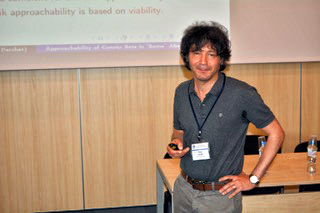Rida Laraki - Majority judgment:Why it should be used to rank and elect
- Keynote Speech

Rida Laraki is director of research CNRS in computer science at LAMSADE (Dauphine-PSL). He graduated from the Ecole Polytechnique in 1996 and did a PhD in Mathematics at the University Pierre et Marie Curie. From 2006 to 2017, he was part-time professor at the École Polytechnique and since September 2017, he is honorary professor at the University of Liverpool. His research is in game theory, social choice, economic theory, optimization, learning, and operations research. He is associate editor in 3 international journals, is responsible of the doctoral program in computer science at the University of Paris Dauphine, and responsible of the french scientific society on the mathematics of optimization and decision: SMAI-MODE.
Every well-known voting system in use today hides important vices that can deny the will of the electorate including majority vote with only two candidates (the domination paradox), approval voting, all methods that ask voters to compare candidates (i.e., rank-order them), and point-summing methods. The underlying reason: the inability of voters to adequately and honestly express their opinions.
Majority judgment asks voters to evaluate every candidate in an easily understood common language of ordinal grades such as: Great, Good, Average, Poor, or Terrible. Majorities determine the electorate’s evaluation of each candidate and the ranking between every pair of candidates (necessarily transitive), with the first-placed among them the winner.
Majority judgment is described together with illustrations of its use (notably, French and U.S. presidential elections).
It was specifically designed to
• permit voters to express their opinions,
• be meaningful in the sense of measurement theory,
• avoid Condorcet’s paradox (guarantee a transitive order-of-finish),
• avoid Arrow’s paradox (when the order-of-finish of two candidates depends on the presence/absence of other candidates),
• combat strategic manipulation and encourage the honest expression of opinions.
Majority judgment has proven itself in practice. It can and should be used in elections with many voters as well as by juries with few judges (e.g., for figure skaters, gymnasts, wines, films, restaurants, prize winners, . . . ).
Some references :
• M. Balinski and R. Laraki. 2011. Majority Judgment: Measuring, Ranking, and Electing, M.I.T. Press.
• – and –. 2013. “Jugement majoritaire versus vote majoritaire (via les présidentielles 2011-2012).” Revue Française d’Economie XXVII 11-44.
• – and –. 2014. “Judge: Don’t Vote! ”, Operations Research 62 483-511.
• – and –. 2016. “Trump and Clinton victorious: proof that US voting system doesn’t work,” TheConversation, May (available on web).
• M. Balinski. 2016. “How majority voting betrayed voters again in 2016,” TheConversation, December (available on web).
• –. 2018. “Réponse à des critiques du jugement majoritaire,” CREST, working paper series #2018-10 (available on web).




